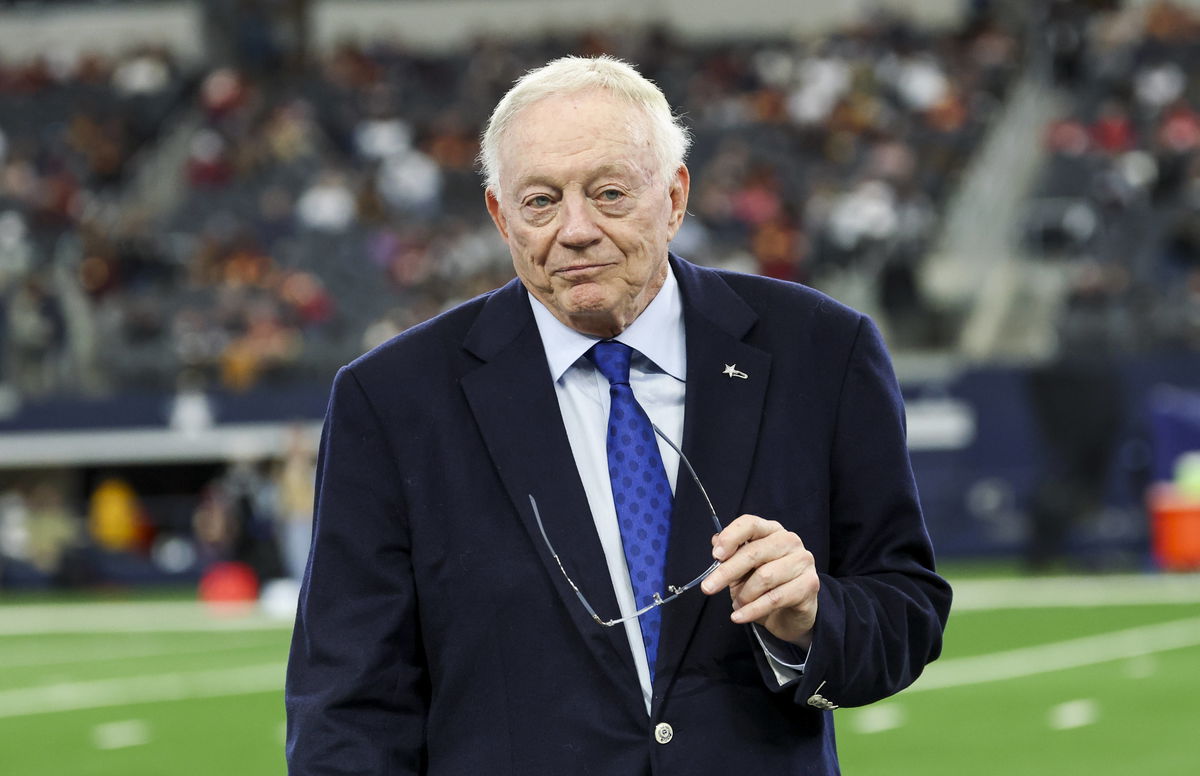
Imago
NFL, American Football Herren, USA Washington Commanders at Dallas Cowboys Jan 5, 2025 Arlington, Texas, USA Dallas Cowboys owner Jerry Jones before the game against the Washington Commanders at AT&T Stadium. Arlington AT&T Stadium Texas USA, EDITORIAL USE ONLY PUBLICATIONxINxGERxSUIxAUTxONLY Copyright: xKevinxJairajx 20250105_krj_aj6_0000325

Imago
NFL, American Football Herren, USA Washington Commanders at Dallas Cowboys Jan 5, 2025 Arlington, Texas, USA Dallas Cowboys owner Jerry Jones before the game against the Washington Commanders at AT&T Stadium. Arlington AT&T Stadium Texas USA, EDITORIAL USE ONLY PUBLICATIONxINxGERxSUIxAUTxONLY Copyright: xKevinxJairajx 20250105_krj_aj6_0000325
There’s a reason why Nick Sirianni said these lines after lifting the Lombardi Trophy: “It takes everybody. That’s why I laugh sometimes when they’re like, ‘Hey, well, they’re so stacked as a team.'” A few years back, Eagles’ general manager Howie Roseman leaned into a contract tactic that turned heads around the league. He’d convert big chunks of salary into signing bonuses, then add “void years.” These were the extra seasons that exist only on paper. This clever move let Philly stretch cap hits over five years instead of two/three, creating immediate breathing room. It wasn’t a loophole exactly, but it blurred the line between smart planning and creative accounting.
Watch What’s Trending Now!
Fast forward to today, and that strategy has played out beautifully. With quarterback Jalen Hurts and stars like A.J. Brown locked up, the cap charges register early, but later seasons bring astronomical dead money. It’s a tactic on confidence: performance today, flexibility tomorrow, and perhaps another extension before the bill arrives.
Now, as media reels from the sheer volume, the question looms: Did Jerry Jones and Dallas misread Dak Prescott’s value while Philly’s cap wizardry set a higher bar? Recently, statistics around the Eagles and the Cowboys‘ cap hit came to light, which claimed that Jalen Hurts, A.J. Brown, DeVonta Smith, and Saquon Barkley‘s combined cap hits for 2025 are $53.4 million. Prescott, on the other hand? It’s $50.5 million. Alone.
ADVERTISEMENT
Jalen Hurts, A.J. Brown, DeVonta Smith, and Saquon’s combined cap hits for 2025: $53.4M
Dak Prescott’s 2025 cap hit: $50.5M
— Brenden Deeg (@BrendenDeeg_) July 1, 2025
Let’s understand what it is. Entering the 2025 season, Philly’s top players are entering with a much lower cap hit than the Cowboys’ quarterback alone. We’re talking about Hurts ($21.86 million), Brown ($17.59 million), Smith ($7.5 million), and Barkley ($6.6 million). Prescott, on the other hand, is carrying a whopping $50.4 million cap hit for the upcoming season.
Now, many argue that Prescott’s cap hit looks scary in a given year, while it sounds like master wizardry from Howie Roseman and the Eagles. And it’s understandable. But let’s not get ahead of ourselves—void years don’t erase money, they just hide it for a while. When Philly restructures deals into bonuses and adds fake seasons, they’re basically borrowing cap space from tomorrow to spend today.
ADVERTISEMENT
That’s why Hurts looks cheap in 2025 despite having an average annual value of $51 million. Same for AJ Brown, Smith, and Barkley as well, who have an average annual value of $32M, $25M, and $20.6M, respectively. Yet, their cap hit is low. But there’s a wrinkle. Fast forward a few seasons, though, and all those prorated chunks come roaring back as dead money the second a player leaves or retires.
At one point or another in the future, the Eagles will eventually have to pay their debts. It doesn’t matter if their current top-tier players have left the team or retired. The Cowboys’ approach with Prescott, for all its sticker shock, is a little more straightforward. They’re taking a hit while Prescott is still producing, rather than gambling that he’ll be elite forever. Their difference with the Eagles? Well, Dallas eats the big number now, sure. But they’re avoiding a time bomb later.
ADVERTISEMENT
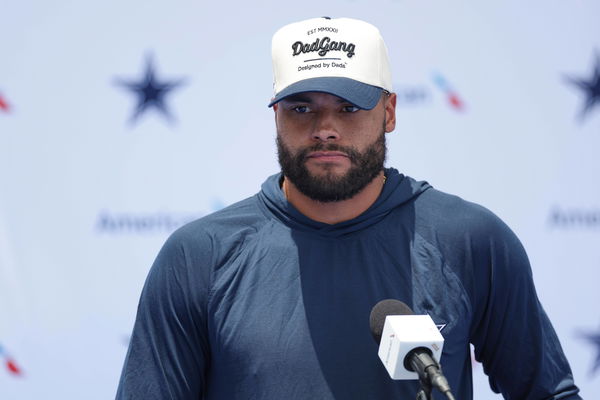
Imago
OXNARD, CA – JULY 25: Dallas Cowboys quarterback Dak Prescott 4 speaks with reporters during the team s training camp at River Ridge Playing Fields on July 25, 2024 in Oxnard, CA. Photo by Brandon Sloter/Icon Sportswire NFL, American Football Herren, USA JUL 25 Cowboys Training Camp EDITORIAL USE ONLY Icon240725059
It’s that simple: if Dak’s deal expires or he is to trade at some point, or if he retires, Jerry Jones and Co. won’t face a mountain of accelerated charges beyond the guaranteed portions. Unfortunately, that’s not the case with the Eagles.
ADVERTISEMENT
Will the Eagles’ cap hit strategy backfire in comparison to Jerry Jones and Dallas?
“You could convert some of the money to a signing bonus, which will lower the cap hit,” the Bengals‘ quarterback, Joe Burrow, said on the Pardon My Take podcast earlier this year. “You can push some of the money to the back end of the contract. That lowers the cap hit.” And let’s face it—it definitely made sense. After all, this strategy allows the Eagles to stretch the contracts of their players further and sign young talents on the roster.
A great strategy, no argument. The Eagles have made it to the Super Bowl a couple of times in the last three seasons using this strategy, having won Super Bowl LIX. And a few teams might follow this strategy. However, the Cowboys’ co-owner, Stephen Jones, had a more cautious take on this. Jones observed that, “I know everybody has their different battles with the cap that hit at different times. Philly will have theirs coming up, where they’ll have to make tough decisions.” Translation?
Top Stories
Cam Newton Makes NFL Return Conditions Clear to 32 Teams as Panthers Legend Confirms Retirement Stance
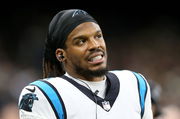
Tom Brady Makes Career Announcement for Vegas as Pete Carroll Addresses Losing Raiders Locker Room

“RIP”: Prayers Pour In as Tom Brady’s Raiders Struck by Tragedy

“NFL Was Crying”: Maxx Crosby Says League Forced Him to Remove Shoes Honoring His Daughter
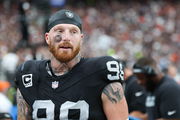
“Rest in Peace”: Prayers Pour In From Dan Marino as Dolphins Legend Mourns Tragedy in South Florida Football
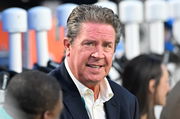
Jones believes that everyone’s got to pay the piper at some point. The Cowboys are doing it at present. Meanwhile, the Eagles are just kicking the can down the road right now. Take Mekhi Becton, for instance. The Eagles signed the 26-year-old guard on a one-year deal last year, on a $5.5 million deal. The kicker? It counted just $2 million on the Eagles’ cap in 2024. That means Philly will now pay him around $3.5 million in 2025. But the interesting fact is that Becton is not even with the Eagles anymore.
ADVERTISEMENT
Sooner or later, all that money the Eagles pushed off is going to catch up with them, and they will eventually have to make some ugly calls. At least that’s what Stephen Jones believes.
ADVERTISEMENT
ADVERTISEMENT
ADVERTISEMENT

